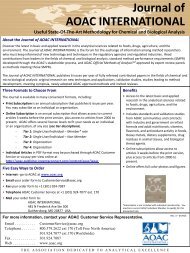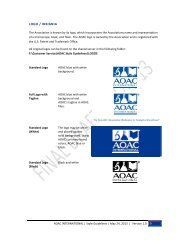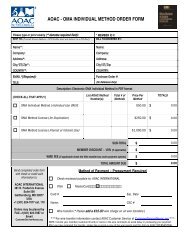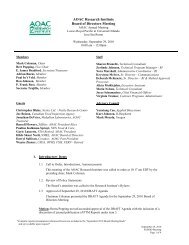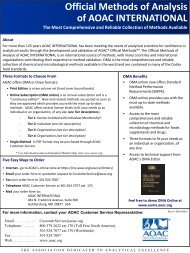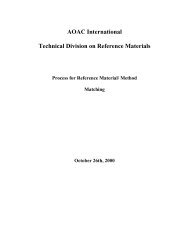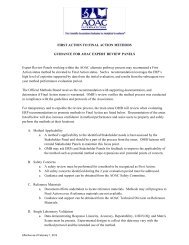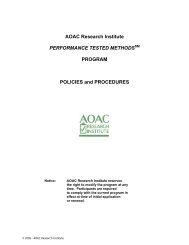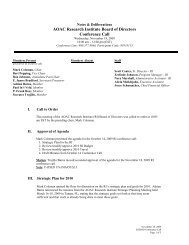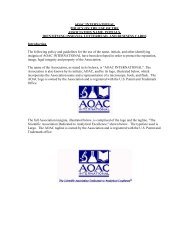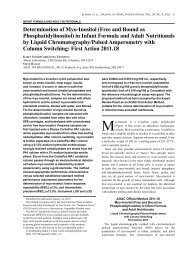Committee I.vp - AOAC International
Committee I.vp - AOAC International
Committee I.vp - AOAC International
- TAGS
- aoac
- www.aoac.org
You also want an ePaper? Increase the reach of your titles
YUMPU automatically turns print PDFs into web optimized ePapers that Google loves.
80B METHODS COMMITTEE REPORTS:JOURNAL OF <strong>AOAC</strong> INTERNATIONAL VOL. 90, NO. 1, 2007<br />
METHODS COMMITTEE REPORTS<br />
<strong>Committee</strong> on Feeds, Fertilizers, and Related Agricultural Topics<br />
LUANN WETZLER,CHAIR<br />
Nebraska Department of Agriculture, 3703 S. 14th St,<br />
Lincoln, NE 68502<br />
NANCY THIEX,SECRETARY<br />
South Dakota University, Olson Biochemistry<br />
Laboratories, Box 2170 SAS 136A, Brookings, SD 57007<br />
SARA WILLIAMS,SAFETY ADVISOR<br />
Office of the Texas State Chemist, PO Box 3160, Ross and<br />
Ireland Sts, 307 Reed McDonald Bldg, College Station, TX<br />
77804<br />
JOHN G. PHILLIPS,STATISTICAL ADVISOR<br />
U.S. Department of Agriculture, Agriculture Research<br />
Service, Eastern Regional Research Center, 600 E.<br />
Mermaid Ln, Windmoor, PA 19038<br />
DARYL S. PAULSON,STATISTICAL ADVISOR<br />
Bioscience Laboratories, Inc., 300 N. Wilson Ave, Suite 1,<br />
Bozeman, MT 59715<br />
MICHAEL P. CARLSON<br />
University of Nebraska-Lincoln, 145 Veterinary Diagnostic<br />
Center, Fair St and E, Campus Loop, Lincoln, NE 68583<br />
MARY G. LEADBETTER<br />
U.S. Food and Drug Administration, Center for Veterinary<br />
Medicine, HFV-143, Rm 337, 7500 Standish Pl, Rockville,<br />
MD 20855<br />
JOHN DENNIS MCCURDY<br />
U.S. Food and Drug Administration, 3949 Sugarloaf Dr,<br />
Monrovia, MD 21770<br />
JAMES MACNEIL<br />
Canadian Food Inspection Agency, 116 Veterinary Rd,<br />
Saskatoon, SK S7N-2R3, Canada<br />
DAVE MERTENS<br />
U.S. Department of Agriculture, Fiber Utilization Laboratory,<br />
Room 261, 1925 Linden Dr W., Madison, WI 53706<br />
RODNEY J. NOEL<br />
Office of the Indiana State Chemist, Purdue University,<br />
1154 Biochemistry Bldg, West Lafayette, IN 47907<br />
<strong>Committee</strong> Actions<br />
Two collaborative studies have been successfully<br />
completed, 2 studies are in progress, and 1 new protocol has<br />
been received and is in review. OMA-2004-Jul-012<br />
Monensin, Narasin, and Salinomycin, LC Method received<br />
First Action approval as <strong>AOAC</strong> Method 2006.01.<br />
OMA-2004-Nov-023 Arsenic, Cadmium, Cobalt, Chromium,<br />
Lead, Molybdenum, Nickel, and Selenium in Fertilizer by<br />
Microwave Digestion and ICP-OES Detection was approved<br />
as <strong>AOAC</strong> Method 2006.03. Protocols for<br />
OMA-2004-Oct-017 Oxytetracycline, LC Method and<br />
OMA-2005-Jan-002 Lasalocid were approved and studies are<br />
underway. Three topics have been recommended to be<br />
discontinued. OMA-2006-Jun-050 Determination of<br />
Decoquinate in Feeds by Liquid Chromatography has been<br />
received and the protocol has been approved. A study titled<br />
“Sampling of Fertilizer Materials and Blends from Bulk Bags<br />
Designed to Hold Approximately 1 Ton of Material: Bag<br />
Probing Technique Compared to <strong>AOAC</strong> Fertilizer Stream<br />
Cutting Technique” has been received and is under<br />
<strong>Committee</strong> review. 982.01 Boron in Fertilizers has undergone<br />
revision to incorporate a method modification.<br />
OMA Chapter 5, Section 5.1.02: As part of the revision of<br />
this chapter, the <strong>Committee</strong> recommends a revision of <strong>AOAC</strong><br />
Official Method 950.02, Preparation of Test Sample, to<br />
provide additional and current information and to make it<br />
consistent with the same method in Section 4.1.02 of<br />
Chapter 4. The proposed wording is: Reduce particle size of<br />
laboratory sample selecting a method, which minimizes loss<br />
of moisture and maintains integrity of constituents of<br />
analytical interest. For feeds containing heat-sensitive<br />
analytes, grind to pass 2.0 mm sieve; for other feeds grind to<br />
pass 1.0 mm sieve. Store the analytical sample under<br />
conditions that minimize degradation of components and<br />
exposure to the atmosphere.<br />
The driving force for new methods entering the<br />
collaborative study process in the past year continues to be the<br />
Agricultural Materials Community and its subgroups. A<br />
summary of the activities of the Community is available on the<br />
<strong>AOAC</strong> Website at http://www.aoac.org/Ag_Materials/<br />
community.htm. Information on the Fertilizer Subgroup is<br />
available at http://www.aoac.org/Ag_Materials/fertilizer/<br />
mission.htm and information on the Feed Additives and<br />
Contaminants Subgroup is available at http://www.aoac.org/<br />
Ag_Materials/additives/main.htm.<br />
Antibiotics in Feeds, Hussein Ragheb<br />
No reports regarding analysis of antibiotics in animal feeds<br />
were received from any of the Study Directors. There was no<br />
indication of any specific problems in the microbiological<br />
assays.<br />
Research activities continued in the General Referee<br />
laboratory. The emphasis was to study the turbidimetric<br />
analysis of chlortetracycline in feeds. In 1977, the
turbidimetric method was developed by our laboratory. It was<br />
approved First Action by <strong>AOAC</strong>, and Final Action in 1996<br />
(977.37) for feed supplements containing more than (or equal<br />
to) 22 g/kg. It was not approved for complete feeds.<br />
We concentrated our efforts on studies of all factors<br />
influencing the growth of the test organism (S. aureus). In<br />
1980, Chiang reported that Mg ions in feed extracts inhibited<br />
ctc activity [J<strong>AOAC</strong> (1982) 65, 1044–1047]. We conducted<br />
experiments where magnesium sulfate was added to the<br />
turbidimetric assay media. We reasoned that the presence of<br />
magnesium ions will affect growth response to standard and<br />
sample solutions in the same manner. Four blank feeds<br />
(2 cattle, 1 swine, and 1 poultry) were used in standard<br />
addition experiments. Results of the turbidimetric assay were<br />
negatively biased as compared with the plate assay (967.39).<br />
The negative bias increased as the theoretical label potency<br />
decreased (samples extracts more dilute with higher potency<br />
feeds). Furthermore, ctc recovery was poor (about 60%) by<br />
the plate and turbidimetric method for theoretical potency of<br />
5 mg/kg. When the standard reference solutions were<br />
prepared in any of these blank feeds at 1/50 dilutions,<br />
recoveries were good and comparable by both turbidimetric<br />
and plate methods even at theoretical potency of 25 mg/kg.<br />
There were no significant differences in antibiotic recovery<br />
regardless of the type of blank feed used in standard addition<br />
experiments or the method of determination (plate of<br />
turbidity).<br />
However, the use of blank feeds is unacceptable because of<br />
the wide variability of the composition of feeds. This could<br />
lead to errors in estimation of potency. We will continue to<br />
investigate this problem or ctc-HCl determination by the<br />
turbidimetric method especially for low level feeds.<br />
Drugs in Feeds, Harold Campbell<br />
(1) Amprolium, LC Method.—Topic Advisor Fred<br />
Armstrong, Canadian Food Inspection Agency, Ottawa<br />
Laboratory (Carling), Bldg 22, Central Experimental Farm,<br />
960 Carling Ave, Ottawa, ON K1A 0C6, Canada, Tel:<br />
613-759-1299, Fax: 613-759-1260, E-mail:<br />
farmstrong@inspection.gc.ca. The Topic Advisor reports no<br />
progress. There were no publications in 2006 on the<br />
determination of amprolium.<br />
(2) Carbadox.—Topic Advisor Alexander MacDonald,<br />
Pharma Science, Inc., 16 Cypress Ave, North Caldwell, NJ<br />
07006, Tel: 973-228-2392, Fax: 973-228-3498, E-mail:<br />
BeeMac201@aol.com. No activity was reported regarding the<br />
study of an LC method based on the method of Aerts and<br />
Werdmuller [J. Assoc. Off. Anal. Chem. (1988) 71, 484–489].<br />
(3) Chlortetracycline, LC Method.—Topic Advisor<br />
Richard Larson, South Dakota State University, ASC 133, PO<br />
Box 2170, Brookings, SD 57007-1217, Tel: 605-688-6706,<br />
Fax: 605-688-6295, E-mail: Richard.Larson@sdstate.edu.<br />
Work continues on optimizing the method of Houglum and<br />
Larson [J. <strong>AOAC</strong> Int. (1997) 80, 961–965]. A problem<br />
experienced by some other laboratories of mobile phase over<br />
pressuring appears to be related to insolubility of the EDTA as<br />
the mobile phase gradient approaches 60% methanol. Another<br />
METHODS COMMITTEE REPORTS:JOURNAL OF <strong>AOAC</strong> INTERNATIONAL VOL. 90, NO. 1, 2007 81B<br />
laboratory working with the method suggested reducing the<br />
EDTA concentration of the mobile phase buffer from 20 to<br />
5 mM. A Study Director has been identified and is beginning a<br />
single-laboratory validation (SLV) using this modification to<br />
the method. A collaborative study is anticipated pending the<br />
outcome of the SLV.<br />
(4) Decoquinate, LC Method.—Study Director Anivis<br />
Sanchez, Canadian Food Inspection Agency, Ottawa<br />
Laboratory (Carling), Bldg 22, Central Experimental Farm,<br />
960 Carling Ave, Ottawa, ON K1A 0C6, Canada, Tel:<br />
613-759-1298, Fax: 613-759-1260, E-mail:<br />
Sanchezaa@inspection.gc.ca. The collaborative study of an<br />
LC method of analysis of decoquinate in feeds and mineral<br />
premixes has been approved by the Feed Additives and<br />
Contaminants Subgroup of the Agricultural Materials<br />
Community. Information will be posted on the <strong>AOAC</strong><br />
Website. The interlaboratory study is being planned for late<br />
2006 or early 2007.<br />
(5) Ivermectin.—Method Advisor James A. Whitehead,<br />
Merial Ltd., 3360 Maury Ave, St. Louis, MO 63116, Tel:<br />
314-752-8053, Fax: 314-752-8061. The current Peer-Verified<br />
Method and interlaboratory study information is published,<br />
(1994) J. <strong>AOAC</strong> Int. 77, 1353–1358.<br />
(6) Lasalocid.—Study Director Charles L. Focht,<br />
Nebraska Department of Agriculture, 3703 S. 14th St,<br />
Lincoln, NE 68502-5399, Tel: 402-471-2176, Fax:<br />
402-471-0091, E-mail: cfocht@agr.ne.gov. A collaborative<br />
study was conducted in September–October 2005, using<br />
8 samples in blind duplicate covering a range of guarantees<br />
from the premix level (68 g/lb) to finished feed level (30 g/T).<br />
In addition, 2 sample pairs contaminated at the residue level<br />
were included as a component for residue testing. The sample<br />
materials were sent to 20 laboratories, and 17 laboratories<br />
returned data. The initial data review indicated that<br />
performance on residue level samples was much poorer than<br />
anticipated, suggesting inadequate sample preparation and/or<br />
instructions to collaborators. Three new residue level samples<br />
were sent to participants as blind duplicates using the identical<br />
procedure as was used for the original sample distribution (but<br />
with revised LC standard solution concentrations). Fifteen<br />
laboratories volunteered and all returned data, with the<br />
majority of work performed in April–May 2006. Results for<br />
the supplemental samples were much improved. The Study<br />
Director believes the majority of parameters defined by the<br />
Method Needs and Fitness for Purpose Document have been<br />
met. The Study Director will submit the study report to<br />
<strong>AOAC</strong>’s Manuscript Central and to <strong>Committee</strong> on Feeds, and<br />
Fertilizers, and Related Agricultural Topics in the fall of 2006.<br />
(7) Melengestrol Acetate in Feeds.—Topic Advisor Dawn<br />
A. Merritt, Pharmacia Animal Health, MR 7926-300-409, 301<br />
Henrietta St, Kalamazoo, MI 49007, Tel: 616-833-2382, Fax:<br />
616-833-7721, E-mail: dawn.a.merritt@pfizer.com. There is<br />
no activity to report.<br />
(8) Monensin, Narasin, and Salinomycin, LC<br />
Method.—Study Director Harold Campbell, Canadian Food<br />
Inspection Agency, Ottawa Laboratory (Carling), Bldg 22,<br />
Central Experimental Farm, 960 Carling Ave, Ottawa, ON
82B METHODS COMMITTEE REPORTS:JOURNAL OF <strong>AOAC</strong> INTERNATIONAL VOL. 90, NO. 1, 2007<br />
K1A 0C6, Canada, Tel: 613-759-1227, Fax: 613-759-1260,<br />
E-mail: hcampbell@inspection.gc.ca. The manuscript for the<br />
joint ISO/<strong>AOAC</strong> collaborative study was reviewed, revised,<br />
and accepted by <strong>AOAC</strong> INTERNATIONAL as First Action<br />
2006.01 Analysis of Monensin, Narasin, and Salinomycin in<br />
Premixes and Animal Feeds by Liquid Chromatography and<br />
Post-Column Derivatization.<br />
(9) Monensin, LC Method.—Method Advisor Mark R.<br />
Coleman, Elanco Animal Health, A Division of Eli Lilly and<br />
Co., 2001 W. Main St, Greenfield, IN 46140, Tel:<br />
317-277-4613, Fax: 317-277-4167, E-mail:<br />
Coleman_Mark_R@lilly.com. Method 997.04 Monensin in<br />
Premix and Animal Feeds has Final Action status.<br />
(10) Morantel Tartrate.—A Topic Advisor is required. An<br />
LC method is desired; method published by Goras and<br />
Gauthier [(1985) J. Assoc. Off. Anal. Chem. 68, 598–601] is a<br />
good possibility.<br />
(11) Narasin, LC Method.—Topic Advisor, Mark R.<br />
Coleman.<br />
(12) Nicarbazin.—The Topic Advisor position is vacant.<br />
An interlaboratory study of an LC method was reported by de<br />
Jong et al. [(2004) J. <strong>AOAC</strong> Int. 87, 1269–1277]. An LC<br />
method reported by Krabel et al. [(2000) J. <strong>AOAC</strong> Int. 83,<br />
1027–1037] is also a viable method.<br />
(13) Oxytetracycline, LC Method.—Study Directors<br />
Richard Larson and Nancy Thiex, Olson Biochemistry<br />
Laboratories, South Dakota State University, SAS 133, Box<br />
2170, Brookings, SD 57006, Tel: 605-688-6706, Fax:<br />
605-688-6295, E-mail: Richard.Larson@sdstate.edu; Tel:<br />
605-688-5466, Fax: 605-688-6295, E-mail:<br />
Nancy.Thiex@sdstate.edu. A collaborative study based on the<br />
method of Houglum, Larson, Mutchler, and Wetzler [(1998) J.<br />
<strong>AOAC</strong> Int. 81, 919–922] was conducted to evaluate the<br />
applicability, repeatability, and reproducibility in animal and<br />
fish feeds, premixes, and animal remedies. The HPLC method<br />
utilizes the extraction solution from <strong>AOAC</strong> Method 957.23<br />
followed by separation on reversed-phase C18 column and<br />
fluorescence detection. The mobile phase gradient runs from<br />
15–35% methanol over 8 min with an initial 1 min hold time.<br />
The aqueous component contains calcium chloride, disodium<br />
EDTA, and sodium acetate buffered to pH 6.5. The presence<br />
of chlortetracycline or other drugs does not interfere with the<br />
analysis of oxytetracycline.<br />
A set of 28 samples including 14 blind duplicates were<br />
shipped to 17 laboratories. Study samples included animal<br />
feeds, animal feed premixes and concentrates, mineral<br />
premixes, and animal remedies. OTC levels ranged from a<br />
few mg/kg to over 400 000 mg/kg. Also included in the<br />
shipment were 4 familiarization samples with OTC levels<br />
from 50 to 400 000 mg/kg. Collaborators were required to<br />
obtain acceptable results on the familiarization samples and<br />
meet system suitability requirements before proceeding to<br />
analysis of the study samples. Results were returned from<br />
10 laboratories. A report on the collaborative study was<br />
presented at the 2006 <strong>AOAC</strong> Annual Meeting.<br />
(14) Pyrantel Tartrate.—A Topic Advisor is required. An<br />
LC method is desired.<br />
(15) Roxarsone.—Topic Advisor Margaret Pomeroy,<br />
Alpharma Inc., Animal Health Division, 400 State St, Chicago<br />
Heights, IL 60411-1242, Tel: 708-758-0111, Fax:<br />
708-757-2510, E-mail: peggy.pomeroy@alpharma.com.<br />
<strong>AOAC</strong> Official Method 971.47 is the most commonly used<br />
procedure for roxarsone (3-nitro-4-hydroxyphenyl arsonic<br />
acid) in feeds. There was no activity on the development of an<br />
LC method.<br />
(16) Sulfamethazine, LC Post-Column Method.—Method<br />
Advisor Kendrick Albert, Office of the Indiana State Chemist,<br />
Purdue University, 1154 Biochemistry Bldg, West Lafayette,<br />
IN 47907-1154, Tel: 765-496-3079, Fax: 765-494-4331,<br />
E-mail: albertk@purdue.edu.<br />
Method 999.16 Liquid Chromatographic–Post-Column<br />
Derivatization has Final Action status. There is no<br />
information to report on either suggested changes, or reported<br />
problems or difficulties.<br />
(17) Tilmicosin.—The Topic Advisor position is vacant.<br />
The current method and interlaboratory study information is<br />
published [(1997) J. <strong>AOAC</strong> Int. 80, 1156–1170].<br />
(18) Tylosin, LC Method.—Topic Advisor Mark R.<br />
Coleman. There is no activity to report.<br />
(19) New Topics.—Study Directors are solicited for other<br />
topics such as clopidol, diclazuril, fenbendazole,<br />
halofuginone, levamisole, maduramicin,<br />
ormetoprim/sulfadimethoxine, ractopamine, robenidine,<br />
semduramicin, and tiamulin. Interested scientists or<br />
organizations are encouraged to contact <strong>AOAC</strong><br />
INTERNATIONAL for more information.<br />
(20) OMA Chapter 5, Section 5.1.02.—As part of the<br />
revision of this chapter, the General Referee recommends a<br />
revision of <strong>AOAC</strong> Official Method 950.02, Preparation of<br />
Test Sample, to provide additional and current information<br />
and to make it consistent with the same method in Section<br />
4.1.02 of Chapter 4. The proposed wording is: Reduce particle<br />
size of laboratory sample selecting a method, which<br />
minimizes loss of moisture and maintains integrity of<br />
constituents of analytical interest. For feeds containing<br />
heat-sensitive analytes, grind to pass 2.0 mm sieve; for other<br />
feeds grind to pass 1.0 mm sieve. Store the analytical sample<br />
under conditions that minimize degradation of components<br />
and exposure to the atmosphere.<br />
Feeds, Vacant<br />
(1) 2003.05 Crude Fat, Diethyl Ether Extraction, in<br />
Feeds, Cereal Grains, and Forages by<br />
Randall/Soxtec/Submersion Method.—Study Directors<br />
Nancy Thiex and Bryan Gildemeister, E-mail:<br />
bryan.gildemeister@sdstate.edu, Shirley Anderson, Foss<br />
North America, 7682 Executive Dr, Eden Prairie, MN 55344,<br />
Tel: 952-974-9892 ext. 161, Fax: 952-974-9823, E-mail:<br />
sanderson@fossnorthamerica.com. Approved as First Action<br />
Method. Method received for Final Action status in 2006.<br />
Discontinue topic.<br />
(2) 2003.06 Crude Fat, Hexanes Extraction, in Feeds,<br />
Cereal Grains, and Forages by Randall/Soxtec/Submersion<br />
Method.—Study Directors Nancy Thiex, Bryan Gildemeister,
Shirley Anderson. Approved as First Action Method. Method<br />
received for Final Action status in 2006. Discontinue topic.<br />
(3) Inorganic Elemental Constituents of Plant Samples,<br />
Microwave Digestion.—Topic Advisor Robert Miller,<br />
Colorado State University, Fort Collins, CO, Tel:<br />
970-493-4382, Fax: 970-416-5820, E-mail:<br />
rmiller@lamar.colostate.edu and Nancy Thiex. No activity<br />
during the past year. Investigate applicability to feed sample<br />
matrixes. Continue topic.<br />
(4) Microscopy.—Topic Advisor Mike Bucker, Division<br />
of Consolidated Lab Services (DCLS), 1 N. 14th St, Rm 127,<br />
Richmond, VA 23219, Tel: 804-225-4070, Fax:<br />
804-796-7795, E-mail: mbucker@dgs.state.va.us. No activity<br />
during the past year. Continue topic.<br />
(5) Neutral Detergent Fiber, Acid Detergent Fiber, and<br />
Lignin Using Filter Bag Technology.—Topic Advisor<br />
Andrew Komarek, ANKOM Technology Corp., Fairport, NY<br />
14450, Tel: 716-425-3940, Fax: 716-425-3941, E-mail:<br />
akomarek@ankom.com. Continue topic.<br />
(6) Vitamin A, LC Method.—Continue topic.<br />
Fertilizer and Agricultural Liming Materials, Peter<br />
Kane<br />
The GR, Peter Kane, retired effective August 31, 2006. His<br />
recommendation is that Bill Hall be appointed the new GR.<br />
(1) 929.01 Sampling.—Study Director Peter Kane, Office<br />
of the Indiana State Chemist, Purdue University,<br />
Biochemistry Bldg, 175 S. University St, West Lafayette, IN<br />
47907-2063, Tel: 765-494-1560, Fax: 765-494-4331, E-mail:<br />
Kanep@purdue.edu. The Sampling of Fertilizer Bulk Bags<br />
manuscript is essentially complete and will be submitted to<br />
<strong>AOAC</strong>’s ScholarOne system shortly, with a recommendation<br />
that the sampling procedure be approved First Action. (Note<br />
that Doug Caine initiated this study 6–7 years ago, but died<br />
before the manuscript could be written. The effort was then on<br />
hold for a number of years while <strong>AOAC</strong> reworked its business<br />
plan, but now is back on track with a high priority with the<br />
Fertilizer Subcommittee of the Agricultural Materials<br />
Community). Continue study.<br />
(2) 983.02 Potassium, Flame Photometric<br />
Detection.—Study Director Natalie Newlon, Office of the<br />
Indiana State Chemist, Purdue University, Biochemistry Bldg,<br />
175 S. University St, West Lafayette, IN 47907-2063, Tel:<br />
765-494-1563, Fax: 765-494-4331, E-mail:<br />
newlonn@purdue.edu.<br />
(3) Controlled Release Nutrient Extraction.—Study<br />
Director William Hall, The Mosaic Co., PO Box 2000, 3095<br />
County Rd, 640 W, Mulberry, FL 33860-1100, Tel:<br />
863-428-7161, Fax: 863-428-7398. E-mail:<br />
bill.hall@mosaicco.com. Preliminary data was submitted to<br />
the AAPFCO Slow Release <strong>Committee</strong> in 2004. Additionally,<br />
a reference incubation method for testing products in a<br />
biologically active soil system has been tested and is<br />
complete. This allows correlation of the laboratory method to<br />
data generated by an agronomic (reference) method.<br />
Correlations of the 2 methods is high >90. The study<br />
manuscript and method will be submitted to J. <strong>AOAC</strong> Int. and<br />
METHODS COMMITTEE REPORTS:JOURNAL OF <strong>AOAC</strong> INTERNATIONAL VOL. 90, NO. 1, 2007 83B<br />
was presented at the 2006 <strong>AOAC</strong> Annual Meeting. Continue<br />
study.<br />
(4) OMA-2004-Nov-023 Arsenic, Cadmium, Cobalt,<br />
Chromium, Lead, Molybdenum, Nickel, and Selenium in<br />
Fertilizer by Microwave Digestion and ICP-OES<br />
Detection.—Study Directors Peter Kane and William Hall.<br />
The collaborative study manuscript is in review by <strong>Committee</strong><br />
on Feeds, Fertilizers, and Related Agricultural Topics.<br />
(5) 2003.14 Determination of Urea in Fertilizers by<br />
LC.—Study Director Michael Hojjatie, Tessenderlo Kerley<br />
Inc., 2480 Twin Buttes, Sahuarita, AZ 85629, Tel:<br />
520-791-2940, Fax: 520-625-8091, E-mail:<br />
mhojjatie@tkinet.com. No report. Continue study.<br />
(6) 982.01 Boron in Fertilizers.—Study Director Wesley<br />
Hsu, U.S. Borax Inc., 26877 Tourney Rd, Valencia, CA<br />
91355-1847, Tel: 661-287-5400, Fax: 661-287-5495, E-mail:<br />
wesley.hsu@borax.com. A single-laboratory validation<br />
(SLV( was received documenting the need for a method<br />
modification. The method modifications are as follows: (1)<br />
Making an unambiguous statement that the sample is to be<br />
ground and homogenized using <strong>AOAC</strong> 929.02. (2) Usinga<br />
mechanical shaker set at approximately 500 rpm to shake the<br />
sample for 20 min to ensure more consistent results. (3)<br />
Reducing the test portion to 1.00 g to facilitate complete<br />
extraction of boron. The modification was accepted and<br />
Method 982.01 has been revised accordingly.<br />
Nutrients in Soils, Charles Focht<br />
(1) Available Potassium in Soils, Ammonium Acetate<br />
Method.—Study Director Maurice Watson, Department of<br />
Natural Resources, Ohio State University, Wooster, OH<br />
44691-4096, Tel: 330-263-3755, E-mail: Watson.8@osu.edu.<br />
Continue topic.<br />
(2) Plant Available Zinc, Manganese, Iron, and Copper in<br />
Soils, DTPA Method.—Study Director Donald Horneck,<br />
Oregon State University Extension Service, Hermiston<br />
Agricultural Research and Extension Center, PO Box 105,<br />
Hermiston, OR 97838, Tel: 541-567-8321, Fax:<br />
541-567-2240, E-mail: don.horneck@orst.edu. Continue<br />
topic.<br />
(3) Available Phosphorus in Soils, Bray P1<br />
Method.—Study Director Bryan Hopkins University of<br />
Idaho, 1776 Science Center Dr, Idaho Falls, ID 83402-1575,<br />
Tel: 208-529-8376, E-mail:bhopkins@uidaho.edu. Continue<br />
topic.<br />
<strong>AOAC</strong> Soil Methods Validation Status<br />
There are currently 3 pending collaborative study reports<br />
in the area of nutrients in soils, as cited above. Study data for<br />
Plant Available Zinc, Manganese, Iron, and Copper in Soils,<br />
DTPA Method is being compiled and a study manuscript<br />
cowritten by Study Director Don Horneck and Ed Hanlon,<br />
Chair of the Soils Subcommittee of <strong>AOAC</strong>’s Task Force on<br />
Agricultural Materials. Study Director Maurice Watson has<br />
submitted the report on Available Potassium in Soils,<br />
Ammonium Acetate Method to Hanlon and Charles Focht, GR<br />
for Nutrients in Soils. Both reports are expected to be
84B METHODS COMMITTEE REPORTS:JOURNAL OF <strong>AOAC</strong> INTERNATIONAL VOL. 90, NO. 1, 2007<br />
submitted to <strong>AOAC</strong> Manuscript Central for review by the<br />
Methods <strong>Committee</strong> on Feeds, Fertilizers, and Related<br />
Agricultural Topics. <strong>Committee</strong> S889 of the Soil Science<br />
Society of America (SSSA) is responsible for proposing new<br />
soil testing methods for official validation. This committee<br />
has decided to wait until <strong>AOAC</strong> reviews the potassium and<br />
the zinc, manganese, iron, and copper before recommending<br />
any new validation initiatives. The committee is awaiting<br />
submission of the Available Phosphorus in Soils study report<br />
to conduct an initial review before submitting it to <strong>AOAC</strong> for<br />
considerations.<br />
Tobacco, Harold Burton<br />
GR Harold Burton retired this year. The proposed GR is<br />
Serban Moldoveanu, R.J. Reynolds Tobacco Co., 950<br />
Reynolds Blvd, Winston-Salem, NC 27105, Tel:<br />
336-741-7948, E-mail: moldovs@rjrt.com. Interest has been<br />
expressed regarding the continuation of interaction between<br />
<strong>AOAC</strong> and the tobacco scientific community. Within the last<br />
2 years, a number of papers that could have been connected to<br />
<strong>AOAC</strong> were published by analytical chemists from tobacco<br />
industry in journals such as Beitaege zur Tabakforschung<br />
<strong>International</strong>. To mention only 2 of them (both papers can be<br />
viewed at www.beitraege-bit.de): (1) “A collaborative study<br />
for determination of tobacco specific nitrosamines in tobacco”<br />
by W.T. Morgan, J.B. Reece, C.H. Risner, C.B. Bennet, C.H.<br />
Midgett, K.S. Johnson, H.R. Burton (2004) Beitr. Tabak.<br />
Intern. 21, 192–203. (2) “Analysis of minor alkaloids in<br />
tobacco: A collaborative study” by P. Chen, N. Qian, H.<br />
Burton, S.C. Moldoveanu (2005) Beitr. Tabak. Intern. 21,<br />
369–379.<br />
With Burton's retirement, the interaction between the<br />
tobacco chemists community and <strong>AOAC</strong> should not be<br />
interrupted. An annual meeting of tobacco scientists (60th<br />
TSRC) took place this year in Montreal, Canada (September<br />
17–20, 2006). The TCRC also hosts a number of committees<br />
including the Analytical Methods committee.<br />
Veterinary Analytical Toxicology<br />
GR position has been vacant for a couple of years. It needs<br />
to be filled with a highly motivated methods standardization<br />
“champion” who can recruit methods projects and facilitate<br />
their progress through <strong>AOAC</strong> INTERNATIONAL. Merl<br />
Raisbeck has volunteered to serve as “Acting GR” for the<br />
immediate and to initiate an effort to survey the Veterinary<br />
Analytical Toxicology Community for the most appropriate<br />
person to perform this effort and to determine what methods<br />
are potentially “in the track” toward <strong>AOAC</strong> validation. The<br />
other members of the informal task force include Mike Carson<br />
(NE), Dirk Holstege (CA), and Christina Wilson (IN).



